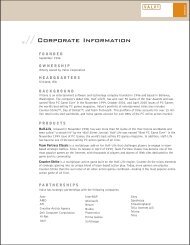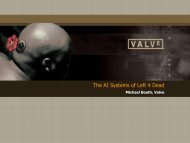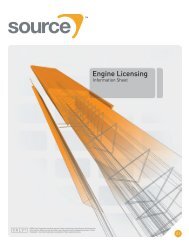Illustrative Rendering in Team Fortress 2 (pdf) - Valve
Illustrative Rendering in Team Fortress 2 (pdf) - Valve
Illustrative Rendering in Team Fortress 2 (pdf) - Valve
You also want an ePaper? Increase the reach of your titles
YUMPU automatically turns print PDFs into web optimized ePapers that Google loves.
Section 5, we will discuss our shad<strong>in</strong>g algorithms <strong>in</strong> detail, before<br />
conclud<strong>in</strong>g with the topics of abstraction and future work.<br />
2 Related Work<br />
Non-photorealistic render<strong>in</strong>g styles can vary greatly, though they<br />
all ideally draw from some real-world artistic techniques under the<br />
assumption that such techniques developed by humans have <strong>in</strong>herent<br />
value due to the evolutionary nature of art. In the exist<strong>in</strong>g NPR<br />
literature, the commercial illustrative styles which <strong>in</strong>spired the look<br />
of <strong>Team</strong> <strong>Fortress</strong> 2 are most closely related to the technical illustration<br />
techniques codified <strong>in</strong> [Gooch et al. 1998]. In Gooch shad<strong>in</strong>g,<br />
the traditional Phong model [Phong 1975] is modified us<strong>in</strong>g a coolto-warm<br />
hue shift to <strong>in</strong>dicate surface orientation relative to a given<br />
light source. As a result, extreme lights and darks are reserved for<br />
edge l<strong>in</strong>es and highlights, result<strong>in</strong>g <strong>in</strong> a clearer perception of 3D<br />
object structure under difficult light<strong>in</strong>g situations than traditional<br />
computer graphics light<strong>in</strong>g models. In the world of <strong>Team</strong> <strong>Fortress</strong> 2,<br />
characters and other objects can be viewed under a wide variety of<br />
light<strong>in</strong>g conditions and thus we employ a similar system so that<br />
characters are clearly identifiable and aesthetically pleas<strong>in</strong>g even <strong>in</strong><br />
difficult light<strong>in</strong>g situations.<br />
While the Gooch shad<strong>in</strong>g algorithm maps an unclamped Lambertian<br />
term to a warm-to-cool hue shift to improve shape perception,<br />
others have created a cel-shaded look by mapp<strong>in</strong>g this term to a<br />
very small set of colors with a hard transition at the term<strong>in</strong>ator<br />
(where the Lambertian term crosses zero) [Decaud<strong>in</strong> 1996] [Lake<br />
et al. 2000] [Barla et al. 2006]. To achieve a cel-shaded look, Decaud<strong>in</strong><br />
rendered objects with constant diffuse colors and relied upon<br />
shadow mapp<strong>in</strong>g to attenuate pixels fac<strong>in</strong>g away from a given light<br />
source. Lake does not rely upon shadow mapp<strong>in</strong>g but <strong>in</strong>stead uses a<br />
1D texture lookup based upon the Lambertian term to simulate the<br />
limited color palette cartoonists use for pa<strong>in</strong>t<strong>in</strong>g cels. Lake’s technique<br />
also allows for the <strong>in</strong>clusion of a view-<strong>in</strong>dependent pseudo<br />
specular highlight by <strong>in</strong>clud<strong>in</strong>g a small number of bright texels<br />
at the “lit” end of the 1D texture map. Most recently, Barla has<br />
extended this technique by us<strong>in</strong>g a 2D texture lookup to <strong>in</strong>corporate<br />
view-dependent and level-of-detail effects. Barla also uses a<br />
Fresnel-like term to create a hard “virtual backlight” which is essentially<br />
a rim-light<strong>in</strong>g term, though this term is not designed to<br />
correspond to any particular light<strong>in</strong>g environment.<br />
3 Commercial Illustration Techniques<br />
In the work of the early 20th century commercial illustrators<br />
J. C. Leyendecker, Dean Cornwell and Norman Rockwell as well<br />
as our own <strong>in</strong>ternal concept art, we observed the follow<strong>in</strong>g consistencies<br />
which we used to def<strong>in</strong>e the look of <strong>Team</strong> <strong>Fortress</strong> 2:<br />
• Shad<strong>in</strong>g obeys a warm-to-cool hue shift. Shadows go to cool,<br />
not black.<br />
• Saturation <strong>in</strong>creases at the term<strong>in</strong>ator with respect to a given<br />
light source. The term<strong>in</strong>ator is often reddened.<br />
• High frequency detail is omitted where possible<br />
• On characters, <strong>in</strong>terior details such as cloth<strong>in</strong>g folds are chosen<br />
to echo silhouette shapes<br />
• Silhouettes are emphasized with rim highlights rather than<br />
dark outl<strong>in</strong>es<br />
With these fundamental pr<strong>in</strong>ciples <strong>in</strong> m<strong>in</strong>d, we set out to create art<br />
assets (characters, environments and texture maps) and real-time<br />
shad<strong>in</strong>g algorithms that result <strong>in</strong> render<strong>in</strong>gs with these properties.<br />
In the next section, we will discuss creation of art assets for <strong>Team</strong><br />
<strong>Fortress</strong> 2, before mov<strong>in</strong>g on to the technical shad<strong>in</strong>g details <strong>in</strong> Section<br />
5.<br />
4 Creat<strong>in</strong>g Art Assets<br />
In this section, we will discuss 3D character and world model<strong>in</strong>g<br />
as well as the pr<strong>in</strong>ciples we followed when generat<strong>in</strong>g texture maps<br />
necessary to meet both our gameplay and artistic goals.<br />
4.1 Character Model<strong>in</strong>g<br />
Players of multiplayer combat games such as <strong>Team</strong> <strong>Fortress</strong> 2 must<br />
be able to visually identify other players very quickly at a variety of<br />
distances and viewpo<strong>in</strong>ts <strong>in</strong> order to assess the possible threat. In<br />
<strong>Team</strong> <strong>Fortress</strong> 2 <strong>in</strong> particular, the player’s class—Demo, Eng<strong>in</strong>eer,<br />
Heavy, Medic, Pyro, Spy, Sniper, Soldier or Scout—is extremely<br />
important to gameplay and hence the silhouettes of the n<strong>in</strong>e classes<br />
were carefully designed to be very dist<strong>in</strong>ct from one another, as<br />
shown <strong>in</strong> Figure 2.<br />
Figure 2: The n<strong>in</strong>e character classes of <strong>Team</strong> <strong>Fortress</strong> 2 were designed<br />
to be visually dist<strong>in</strong>ct from one another. Even when viewed<br />
only <strong>in</strong> silhouette with no <strong>in</strong>ternal shad<strong>in</strong>g at all, the characters<br />
are readily identifiable to players. While characters never appear<br />
<strong>in</strong> such unflatter<strong>in</strong>g light<strong>in</strong>g conditions <strong>in</strong> <strong>Team</strong> <strong>Fortress</strong> 2, demonstrat<strong>in</strong>g<br />
the ability to visually read the characters even with no <strong>in</strong>ternal<br />
detail was used to validate the character design dur<strong>in</strong>g the<br />
concept phase of the game design.<br />
The body proportions, weapons and silhouette l<strong>in</strong>es as determ<strong>in</strong>ed<br />
by footwear, hats and cloth<strong>in</strong>g folds were explicitly designed to<br />
give each character a unique silhouette. In the shaded <strong>in</strong>terior areas<br />
of a character, the cloth<strong>in</strong>g folds were explicitly designed to echo<br />
silhouette shapes <strong>in</strong> order to emphasize silhouettes, as observed <strong>in</strong><br />
the commercial illustrations which <strong>in</strong>spired our designs. As we will<br />
discuss <strong>in</strong> Section 5, the shad<strong>in</strong>g algorithms used on these characters<br />
complement our model<strong>in</strong>g choices to enhance shape perception.<br />
4.2 World Model<strong>in</strong>g<br />
The unique look of the world of <strong>Team</strong> <strong>Fortress</strong> 2 is borne out of<br />
well-def<strong>in</strong>ed design pr<strong>in</strong>ciples. For the architectural elements of<br />
the world associated with each of the two teams, blue and red, we






